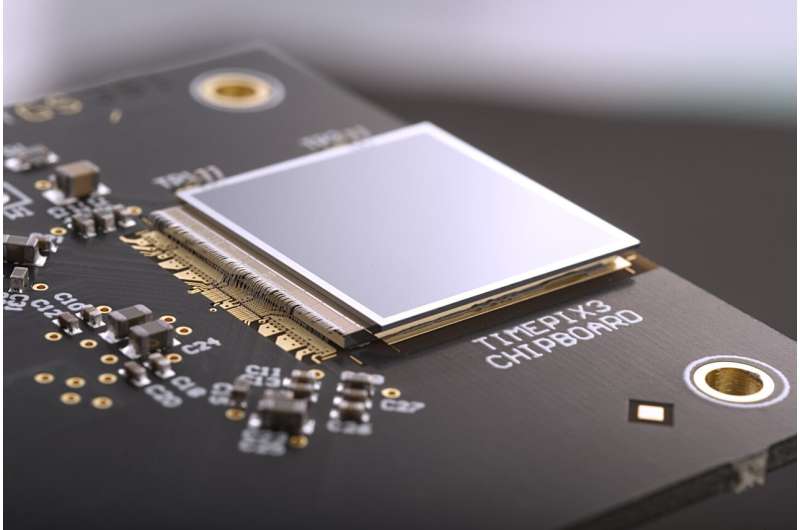This article has been reviewed according to Science X's editorial process and policies. Editors have highlighted the following attributes while ensuring the content's credibility:
fact-checked
trusted source
proofread
Small version of a CERN detector could deliver more precise radiotherapy of head tumors

Particle detectors like the ones used by physicists at CERN can have wide applications beyond fundamental research. Scientists from the German National Center for Tumor Diseases (NCT), the German Cancer Research Center (DKFZ), and the Heidelberg Ion Beam Therapy Center (HIT) at Heidelberg University Hospital are now testing a new imaging device supplied by the Czech company ADVACAM on its first patients.
The device, which includes a small Timepix3 pixel detector developed at CERN, allows head and neck tumors to be closely monitored during ion radiotherapy, making them easier to target and thus helping limit the treatment's side effects.
"One of the most advanced methods for treating head and neck tumors involves irradiation with ion beams. This has one unique feature: it can be precisely tailored to the depth inside the human head where the particles should have the maximal effect," explains Mária Martišíková, the head of the DKFZ team.
Yet like other types of irradiation, ion radiation also has a drawback. The particle beams affect not only the tumor but also part of the healthy tissue around it. This is particularly challenging in the brain, where damage to the optic nerve or a patient's memory are possible. Ideally, the irradiated area around the tumor should be as small as possible, and the dose to the tumor should be as high as possible. However, current technology does not allow for sufficiently precise targeting of the ions.
To complicate matters further, the situation inside a patient's head can change during therapy. The X-ray computed tomography (CT) scan image taken before treatment is essentially used as a "map" to target the tumor with ion beams. But during therapy, the situation inside the skull may evolve. Until now, physicians lacked a reliable tool to alert them in case of a change in the brain.
The new ADVACAM device could help solve these issues, by improving the navigation of the ion beams inside the head by tracking the secondary particles that are created when ions pass through it.
"Our cameras can register every charged particle of secondary radiation emitted from the patient's body. It's like watching balls scattered by a billiard shot. If the balls bounce as expected according to the CT image, we can be sure we are targeting correctly. Otherwise, it's clear that the 'map' no longer applies. Then it is necessary to replan the treatment," says Lukáš Marek from ADVACAM.
"We hope the new device will show us how often and where the tumor changes occur. It will allow us to reduce the overall irradiated volume of tissue, saving healthy tissue and reducing the side effects of radiotherapy. We will also be able to apply higher doses of radiation to the tumor," adds Martišíková.
The treatment can benefit enormously from the additional information obtained from the camera. In the first phase, data could lead to an interruption and replanning of the irradiation series when necessary. The ultimate goal is a system that can correct the path of the ion beam in real time.
This device exemplifies successful knowledge transfer, showcasing how technology initially developed for detectors used in fundamental physics research can be applied in health care.
"When we started developing pixel detectors for the LHC we had one target in mind—to detect and image each particle interaction and thereby help physicists to unravel the secrets of Nature at high energies. The Timepix detectors were developed by the multidisciplinary Medipix Collaborations whose aims are to take the same technology to new fields.
"Many of those fields were completely unforeseen at the beginning and this application is a brilliant example of that," says Michael Campbell, Spokesperson of the Medipix Collaborations.



















